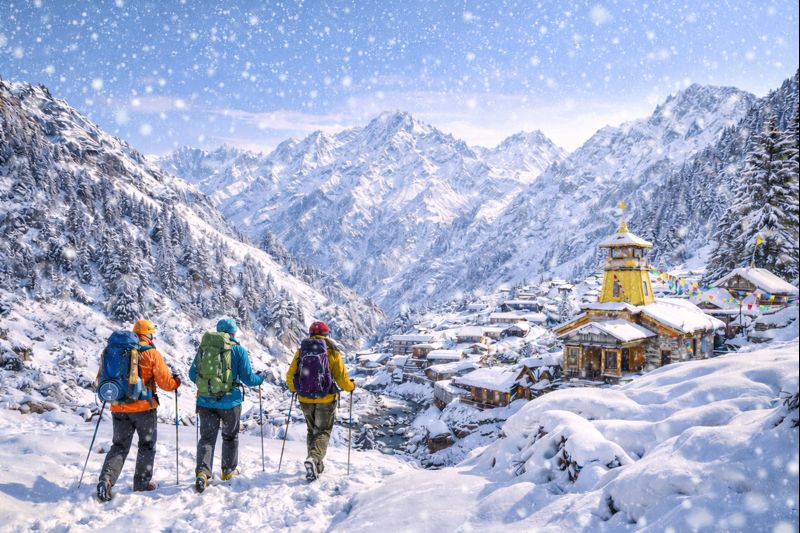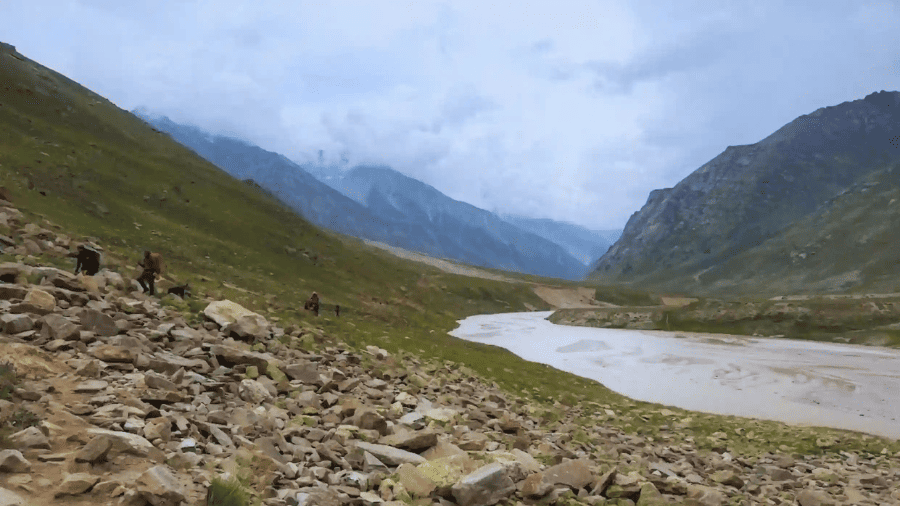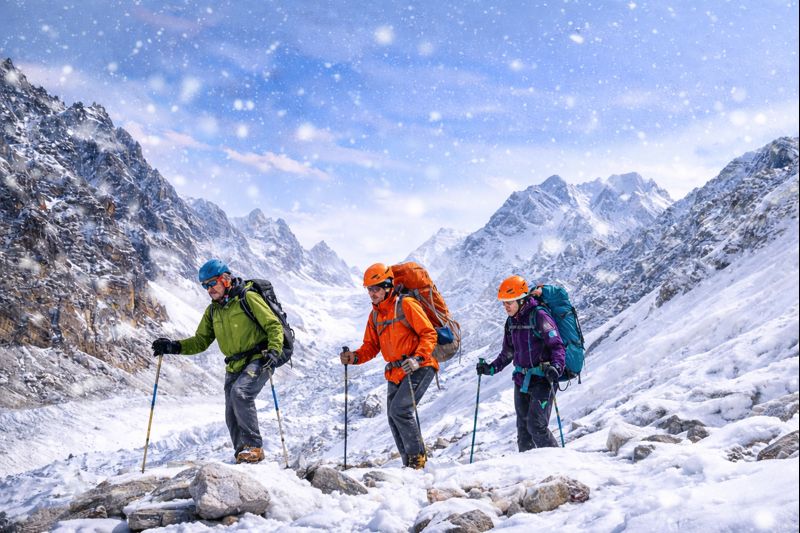
Beauty of Valley of Flower :
The Valley of Flowers trek is located in the Indian Himalayas and stretches over a distance of about 10 kilometers. It is an alpine valley situated in the UNESCO World Heritage Site of Nanda Devi Biosphere Reserve that blooms with a color kaleidoscope of vibrant wildflowers between June and September. It is a moderate hike, it reveals breathtaking landscapes, glacial streams, and a variety of flora including less common species. 3,600 meters high lies this floral paradise right around the trail. The Valley of Flowers trek is highly popular due to its great natural beauty and rich biodiversity, which makes it a true paradise for people interested in nature and adventures.
Gurdwara Hemkund Sahib
The pilgrimage site is dedicated to Guru Gobind Singh, the tenth Sikh Guru, and is revered by Sikhs for its historical and religious significance. Hemkund Sahib holds historical importance as it is believed to be the place where Guru Gobind Singh meditated in his previous life. The star-shaped Gurudwara (Sikh temple) near the lake is a place of worship and reflection for pilgrims. The Gurudwara is open only during the summer months, typically from May to October, due to heavy snowfall in the region during the winter.
The highlight of the pilgrimage is the serene Hemkund Lake, considered to be a sacred Sarovar. Surrounded by snow-clad peaks and vibrant alpine flowers, the crystal-clear lake reflects the awe-inspiring beauty of the Himalayan surroundings. Hemkund Sahib is surrounded by seven snow-capped peaks, collectively known as the Hemkund Parvat
How to reach Valley of Flower
A trip to the magical Valley of Flowers starts with getting to Haridwar, Rishikesh, or Dehradun transportation centers. Jolly Grant airport in Dehradun is the closest with these cities being linked to it by rail and air. Once you get there, take a direct cab from the several transport companies or trekking organizations that will drop you off at Govindghat.
Govindghat is the starting point for the trek and the distance from there to Ghanghriya is about 14 km. This tour takes about 4-5 hours, so you should start your trip around if it is 7 o’clock or even earlier. Ghanghriya is where the path forks, with one trail taking visitors to Hemkund Sahib, while another leads them on an enchanting journey into the Valley of Flowers.
Most Popular and Beautiful flowers in the Valley of Flower

Brahma Kamal (Saussurea obvallata): This is one of the few mystical flowers present in this area. It is the state flower of Uttarakhand and has an alluring look.
Saussurea obvallata is a perennial growing to 0.3 m (1 ft). Hermaphroditic flowers pollinate insects. (Insects pollinate hermaphrodite flowers). Flowers bloom in mid-monsoon (July–August) amongst the rocks and grasses of the hillside at an altitudinal range of 3700–4600 m. Flower heads are purple, hidden from view in layers of yellowish-green papery bracts, which provide protection from the cold mountain environment. From July through September, you can see the flowers. The above-ground plant parts die back in October and are not visible again until April.
The blue poppy (Meconopsis aculeata), with its striking blue hue, adds color to the area. It is a highland Himalayan species and very rare.
Meconopsis aculeata is a blue-flowered thorny species of the genus Meconopsis with a small geographical distribution restricted to specific areas of Pakistan and India, in the west Himalayas. The species was described from specimens collected here, by Royle in 1833. It is also known as Bhoti ‘Tsersnon’ in Ladakh. Along with Juniperus polycarpos (also known as Bhoti ‘Shukpa’), it is used in the Sowa-Rigpa (also known as Amchi system) traditional medicine system. Both have been proposed as the state flower and state tree respectively by the Ladakh administration.
Cobra Lily (Arisaema flavum): This flower, sometimes called the yellow cobra lily, is an interesting-looking one that has a hood resembling a snake’s head.
Arisaema is a large and diverse genus of the flowering plant family Araceae. The largest concentration of species is in China and Japan, with other species native to other parts of southern Asia as well as eastern and central Africa, Mexico and eastern North America.[1] The distinctive appearance of the Asiatic and Western species’ flowers is referred to as cobra lilies and jack-in-the-pulpit, respectively. An erect central spadix rises from a spathe in both types.
Himalayan Primula (Primula denticulata): These are beautiful blue flowers that rose in the alpine meadows adding a carpet of color to the landscape.
Primula is a complex and varied genus, with a range of habitats from alpine slopes to boggy meadows. Plants bloom mostly during the spring, with flowers often appearing in spherical umbels on stout stems arising from basal rosettes of leaves; their flowers can be purple, yellow, red, pink, blue, or white. Some species show a white mealy bloom (farina) on various parts of the plant.[2] Many alpine-adapted species populate those climates.
Himalayan Marsh Marigold (Caltha palustris): Near water bodies and wet areas in the Valley of Flowers, you can find this bright yellow flower.
Himalayan marigold (Caltha Palustris Alba) is a marginal shallow water plant. It is a white flowering form of the more commonly known marsh marigold. The pretty blooms having white petals with yellow centres and we love to see them in flower.
Saxifrages: The rocky landscape is also home to a number of species of saxifrages with their delicate and colorful blossoms.
Most saxifrages are small perennial, biennial (e.g. S. adscendens) or annual (e.g. S. tridactylites) herbaceous plants whose basal or cauline leaves grow close to the ground, often in a rosette. The leaves typically have a more or less incised margin; they may be succulent, needle-like and/or hairy, reducing evaporation
Potentilla: In the Valley of Flowers, a number of potentilla varieties – cinquefoils known for their graceful little flowers.
Typical cinquefoils look most similar to strawberries, but differ in usually having dry, inedible fruit (hence the name “barren strawberry” for some species). Many cinquefoil species have palmate leaves. Some species have just three leaflets, while others have fifteen or more leaflets arranged pinnately. The flowers are usually yellow, but may be white, pinkish or red. The accessory fruits are usually dry but may be fleshy and strawberry-like, while the actual seeds – each one technically a single fruit – are tiny nuts.
Anemone: Windflowers have a frail appearance and come in different colors, including white and pink.
Anemone are perennials that have basal leaves with long leaf-stems that can be upright or prostrate. Leaves are simple or compound with lobed, parted, or undivided leaf blades. The leaf margins are toothy or entire.
Flowers with 4–27 sepals are produced singly, in cymes of 2–9 flowers, or in umbels, above a cluster of leaf- or sepal-like bracts. Sepals may be any color. The pistils have one ovule. The flowers have nectaries, but petals are missing in the majority of species.
Achenes, ovoid to obovoid in shape, are collected in tight clusters that end variously lengthened stalks. Some species, however, have sessile clusters directly terminating their stems. The achenes are beaked and some species have feathery hairs attached to them
Columbines (Aquilegia): In the Valley of Flowers, you can find unique flowers with spurred petals in various colors.
Aquilegia (common names): granny’s bonnet, columbine is a genus of about 60–70 species[2] of perennial plants that are found in meadows, woodlands, and at higher altitudes throughout the Northern Hemisphere, known for the spurred petals of their flowers
Bistorta Affinis: Himalayan Bistort, with its pinkish flowers, grows in alpine meadows.
Himalayan Bellflower (Campanula latifolia): This bell-shaped flower that grows in the Himalayan region adds character to the floral collection.
These are only a few samples, and the Valley of Flowers is host to a plethora of other flowering plants all adding to the breathtaking picture frames provided by this area.
Pushpawati River
Pushpawati River Valley is the beautiful and indispensable part of the Valley of Flowers region in the Indian state, of Uttarakhand. The meandering Pushpawati River flows through the Valley of Flowers, enhancing its heavenly scenery with its streams. The Pushpawati River winds through the valley, known for its rich and diverse alpine vegetation.
The river valley acts as a lifeline for the whole ecosystem, supporting all manner of rich life in this area. Hailed from the run-off glacier water of neighboring hills, it trickles down along the valley giving rise to that ecosystem where there are so many species of wildflowers grow abundantly. The Pushpawati River Valley is not only a geographical form but also an ecological factor that keeps intact stability in the biodiversity scale within Flowers’ Valley itself
Best time to visit Valley of Flower

The best time to visit Valley of Flowers is in summer usually during June end and early September. It is very cold with heavy snowfall in the valley, and it usually becomes cut off at winter.
Late June to July:
It is the peak season when the Valley of Flowers blooms in full. The snow from the winter has melted, and a brilliant carpet of wildflowers lays over the valley in bright colors. However, the weather is generally good during this time.
August:
The flowering season does not end in August; you can still find a wide range of flowers. But some of the flowers that bloom early may begin to wilt. The weather is still good but it may sometimes rain.
Early September:
The flowering season is just ending by mid-September, and the temperature becomes cooler. If you like lesser talk and less crowded, then early September can also be a good time to visit as the total pass is still stunning even though one might miss out on peak bloom.
Nanda Devi National Park Reserve is in the UNESCO World Network of Biosphere Reserves.
The UNESCO World Network of Biosphere Reserves includes Nanda Devi National Park, recognizing its ecological value and biodiversity preservation initiatives. Nanda Devi National Park is located in the Himalayan range and it includes a part of one of the highest Peaks on this soil – Nanda  Devi. The park is a sanctuary for various species of plants and animals, including a range of endangered ones such as the snow leopard, Himalayan tahr, musk deer, etc. The vast ecosystems within the park also help contribute to its rich biodiversity making it a valuable asset for scientific research and ecological preservation.
Visitors to Nanda Devi National Park can enjoy the pure nature of the Himalayas without disturbing their ecological balance. The status of the UNESCO Biosphere Reserve highlights the significance of this area for global conservation and promotes sustainable activities to ensure that the ecosystem remains healthy in the long-term perspective.
About Author

Himalaya Shelter
Recent news

06 Jan 2026

03 Jan 2026

23 Dec 2025
Recommended Treks


